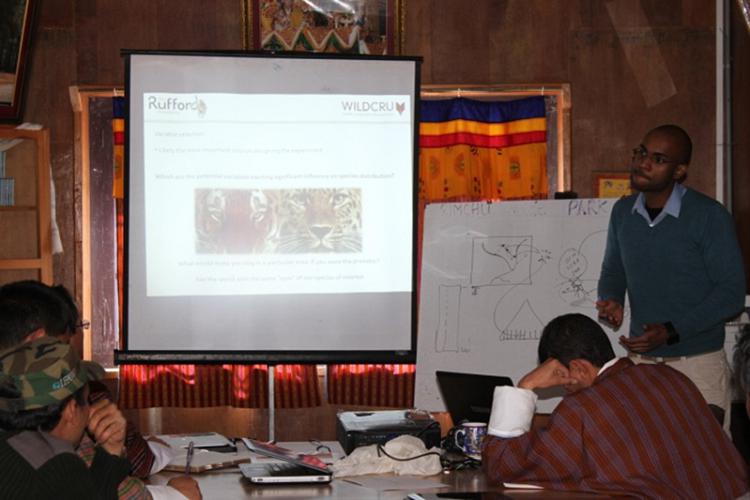Lhendup Tharchen
We aim to guide human-carnivore conflict mitigation strategies in Bhutan by digitizing national records of carnivore attacks on livestock and producing national livestock depredation-risk maps using this database and species distribution model algorithmsultimately – producing evidence-based, management recommendations for consideration by the Nature Conservation Division.

Participant sharing his views on the findings presented.
In Bhutan, carnivore depredation of livestock is one of the main drivers of human-carnivore conflict (HCC), exacerbating the livelihood of rural communities. Such attacks negatively affect local attitude towards carnivores and often lead to retaliatory killings of perceived problem animals, confounding conservation of Bhutan’s rich carnivore fauna, which includes the tiger (Panthera tigris), leopard (P. pardus), snow leopard (Uncia uncia), clouded leopard (Neofelis nebulosa), sloth bear (Ursus ursinus) and dhole (Cuon alpinus). Increases in livestock numbers and expansion of grazing in new areas, combined with a culture of lax livestock husbandry practices, have exacerbated HCC in recent years, making people increasingly less tolerant towards what were once acceptable losses to wildlife. Although the introduction of a compensation scheme for livestock losses to carnivores in 2003 tried to address the problem, compensation alone is not the solution, especially since limited funds meant that as of2006 only claims for losses to tigers could be filed.

Training workshop.
We will digitize the currently hard to access, paper-based carnivore livestock depredation records collected between2003-2012 across Bhutan, permitting their incorporation in a geographic information system, which will be used by a maximum entropy algorithm to model areas of increased livestock vulnerability to depredation. The predictive models will be based on environmental and landscape features and similarities extracted from each attack point location. By identifying high risk areas (hotspots) of human wildlife conflict (HCC), these models will shed light on the environmental and human-related factors contributing to livestock vulnerability to carnivore attack, thus facilitating the development of evidence-based management recommendations for HCC mitigation and carnivore conservation initiatives. These recommendations will be delivered to policy makers and managers at the HCC forefront (e.g. park wardens, foresters), to lessen the pressure on large carnivores from persecution and retaliatory killings.
This project will set the foundation for a series of projects promoting carnivore conservation via HCC mitigation in Bhutan. Following the completion of this proposed project, additional grants (from Rufford Small Grants and other sources) will be sought to test the field implementation of the proposed recommendations.